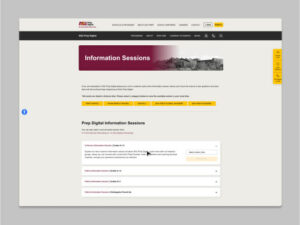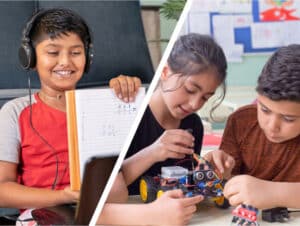With the rapid growth of online learning, more families are opting for virtual education options for their children. In fact, a report by the National Center for Education Statistics found that more than 20% of U.S. students were enrolled in at least one online course by the time they reached high school.
As this trend continues to rise, parents and guardians must not only select the right programs but also understand the associated costs. This blog will guide you through the complexities of online school fees, helping you navigate the financial aspects of virtual education for elementary school, middle school and high school.
Benefits of online learning for elementary to high school students
Online learning offers numerous benefits that make it an appealing choice for students and families. One of the most significant advantages is the flexibility and convenience it provides, allowing students to learn from anywhere and tailor their schedules to fit their individual needs.
This personalized approach ensures that each student can follow a customized learning path that aligns with their unique strengths and interests. With one-on-one teacher support, students receive the guidance they need to succeed, and access to a wide range of resources and courses opens up opportunities for a well-rounded education. The integration of technology enhances the learning experience, making education more engaging and interactive.
Online learning also fosters a safer environment, reducing exposure to physical bullying and other in-school issues, ensuring that students can learn in a comfortable and secure setting.

Understanding the cost of online school: an overview of typical course fees and student fees
When considering online school for your student, understanding the associated costs is key to making an informed decision that fits your family’s needs. The flexibility of online learning often means that tuition fees can be more manageable and tailored to your specific situation. For example, tuition varies by educational level, with options for both full-time and part-time enrollment. In addition, depending on where you live, your student may even qualify for tuition-free online programs. For example, full-time students who reside in Arizona may register for online school through ASU Prep Digital at no cost.
Full-time students in grades 6-12 typically enroll in a minimum of five courses per semester, with tuition spread out over multiple installments, while part-time students can choose courses à la carte, paying only for what they need. For younger students in grades K-5, programs are often fully immersive and designed for a complete, uninterrupted learning experience.
In addition to tuition course fees, technology fees help ensure your student has access to the latest educational platforms and software, often bundled within the tuition. This ensures your student can take full advantage of the digital tools that make online learning so effective. While some programs might require specific devices or software, these are often a one-time investment that enhances the overall learning experience. Many online schools offer convenient online payment options, and use online payment systems, allowing you to manage tuition and other fees easily from the comfort of your home.
Course materials, like e-books and online library access, are typically included, reducing the need for physical textbooks and making it easier to manage resources. Specialized subjects or extracurricular activities may have additional costs, but these enrich the learning experience and are often well worth the investment. For families getting ready to start, a guide on preparing for virtual learning can help you plan ahead.
While there may be some additional fees for services like tutoring or counseling or athletics, these optional costs can provide valuable support tailored to your child’s needs. Overall, the cost of online schooling is an investment in a flexible, personalized education that can be more accessible and adaptable than traditional schooling, making it an excellent choice for many families.
Cost comparison: Online vs. traditional school
When weighing the costs of online versus traditional schooling, it’s important to consider various factors beyond just tuition fees. The following comparison highlights the key cost differences between these two educational paths, helping you make an informed decision that suits your family’s financial and educational needs.
| Cost Factor | Online School | Traditional School |
|---|---|---|
| Tuition Fees | Generally lower due to reduced overhead costs. | If applicable, higher to cover facilities, maintenance, and staffing. |
| Transportation Costs | None, eliminating the need for daily commutes. | Significant expenses, including bus fares or fuel costs. |
| Materials and Resources | Digital textbooks and resources are often more cost-effective. | Physical textbooks, notebooks and supplies, which can be expensive. |
| Technology Expenses | Initial investment in reliable internet and devices (e.g., laptops or tablets). | Potentially lower but may still require personal devices for homework. |
| Extracurricular Activities | Often included or available at a lower cost. | Additional fees for sports, clubs, and other activities. |
| Dress Code | Lower as students are free to wear whatever they find comfortable. | Costs for purchasing and maintaining uniforms or school-appropriate clothing. |
| Miscellaneous Fees | Potentially lower, though some schools may charge for specific services. | Expenses for field trips, lab fees, and other school events. |
| In-Person Attendance Costs | None, as all learning takes place virtually. | Costs for school supplies kept at school, locker fees, and other on-site expenses. |
| Financial Aid and Scholarships | Availability of financial aid and scholarships can reduce overall costs. | Similar opportunities, but competition and criteria may differ. |
Overall, online schooling can offer significant cost savings, particularly when it comes to transportation, meal costs and uniforms. The flexibility of digital resources and extracurricular activities often included in the program can make online learning a more budget-friendly option.
It’s important to take the needs, mental health, and any special education requirements for your student into consideration as well when considering online school. For a deeper dive into whether online or public school is the best choice for your child, check out our blog, Online school vs public school: What’s the best choice for your child?
Strategies to navigate and manage online school fees
To make the most of your investment in online education, it’s essential to have a strategy in place for navigating and managing school fees. By being proactive and informed, you can ensure your student receives a quality education without straining your budget. Here are some effective strategies to help you manage the costs of online schooling:
- Research and Compare: One of the first steps in managing online school fees is thorough research. Take the time to explore different online schools and understand their fee structures. Look beyond just the tuition costs—consider technology fees, course materials and any additional services that may come with a price tag. Comparing tuition and associated costs across various programs can help you find the best value for your money.
- Budgeting and Financial Planning: Creating a detailed budget for your online education expenses is crucial. Start by listing all potential costs, including tuition, technology, materials and miscellaneous fees. Use financial planning tools and resources to help you track your expenses and adjust your budget as needed. Having a clear financial plan in place will allow you to manage costs more effectively throughout the school year.
- Financial Aid and Scholarships: Many online schools offer financial aid options that can significantly reduce your overall costs. Look into the available scholarships, grants and other forms of financial assistance. Applying for scholarships can be competitive, so be sure to start the application process early and meet all deadlines. Additionally, consider reaching out to the school’s financial aid office for guidance on the best options for your situation.
- Payment Plans and Discounts: To make tuition payments more manageable, many online schools offer flexible payment plans. These plans allow you to spread the cost over several installments rather than paying the entire amount upfront. Additionally, some schools provide sibling discounts or incentives for early payment, which can further reduce your expenses. Be sure to inquire about these options when choosing an online school.
Make sure to thoroughly understand any other information regarding factors such as credit card/debit payments, refunds, electronic checks, school district discounts and the other more technical details that may apply to you. Using these strategies, you can navigate the financial aspects of online schooling with confidence, ensuring that your student receives a quality education while staying within your budget.

Additional tips and resources
To further ease the financial aspects of online schooling, we have some additional tips to help you navigate this journey more effectively:
- Engaging with School Counselors: School counselors and advisors can be invaluable resources when it comes to managing online school fees. They can provide personalized financial guidance and help you explore all available options for reducing costs. Engaging with these professionals early on can help you make the most of school-provided resources, such as information sessions and financial aid workshops. For more details, you might consider joining an information session through the school’s website.
- Community Resources and Support Groups: Don’t underestimate the power of community when it comes to online schooling. Many community programs and support networks offer resources specifically designed to help families manage education expenses. Connecting with other online school parents and students can provide valuable insights and advice on navigating fees and finding additional support. These networks can also be a great way to share experiences and solutions.
- Staying Informed: Staying informed is key to effectively managing online school fees. Keep up-to-date with any changes in school fees, policies, or available financial aid options. Regularly reviewing your financial plans and making adjustments as needed will ensure that you stay on top of your budget throughout the school year. By staying proactive and informed, you can avoid any unexpected financial challenges.
With these additional tips and resources, you can confidently manage the financial aspects of online schooling, ensuring your student receives the education they deserve without unnecessary stress.
Conclusion
Managing online school fees effectively involves understanding the cost structures, exploring financial aid options and leveraging available resources. We’ve reviewed the various elements of online education costs, from tuition and technology fees to additional expenses for materials and activities. By researching different programs, creating a detailed budget and staying informed about changes and financial support opportunities, you can navigate these costs with confidence.
We encourage both parents/guardians and students to take proactive steps in managing online school fees. Engaging with school counselors, utilizing community resources and staying updated on financial matters will help ensure a smooth and affordable educational experience. Remember that investing in online education not only offers flexibility and personalized learning but also sets the stage for long-term academic success and personal growth.
By taking these steps, you can make the most of the opportunities online schooling provides while maintaining financial stability.
Discover the benefits of K–12 online learning ASU Prep Digital
Understanding the various costs associated with online schooling is important, and choosing the right educational platform can make all the difference.
ASU Prep Digital is Arizona’s #1 online school serving students in grades K–12. Our program is tuition-free for full-time students who reside in Arizona. We believe all students can succeed and our flexible, personalized learning experiences are tailored to different needs and preferences. Our unique teaching model supports students anywhere, anytime with the latest learning technologies and several layers of personalized instruction and coaching.
In addition, our program is a college prep option where online high school and university courses converge preparing students for college acceptance and encourages them to start earning credit toward college majors and careers. We support districts in Arizona, while serving students and schools around the world.
Take the first step toward transforming your educational experience by attending an information session. Discover how ASU Prep Digital can support students’ academic aspirations and set them on a path to success.
Navigating online school fees for elementary to high school students FAQs
How do online school fees compare to traditional brick-and-mortar school fees?
Online school fees can vary widely compared to traditional brick-and-mortar schools. Generally, online schools might be less expensive due to lower overhead costs, but this isn’t always the case, as some online programs can be quite costly.
Are there any hidden costs I should be aware of when enrolling in an online school?
Hidden costs in online schooling can include technology fees, costs for required software or materials and potential expenses for in-person exams or activities.
Is financial aid or scholarships available for online school students?
Financial aid and scholarships are often available for online school students, similar to traditional schools. It’s important to check with the specific online institution for available options and eligibility requirements.






















